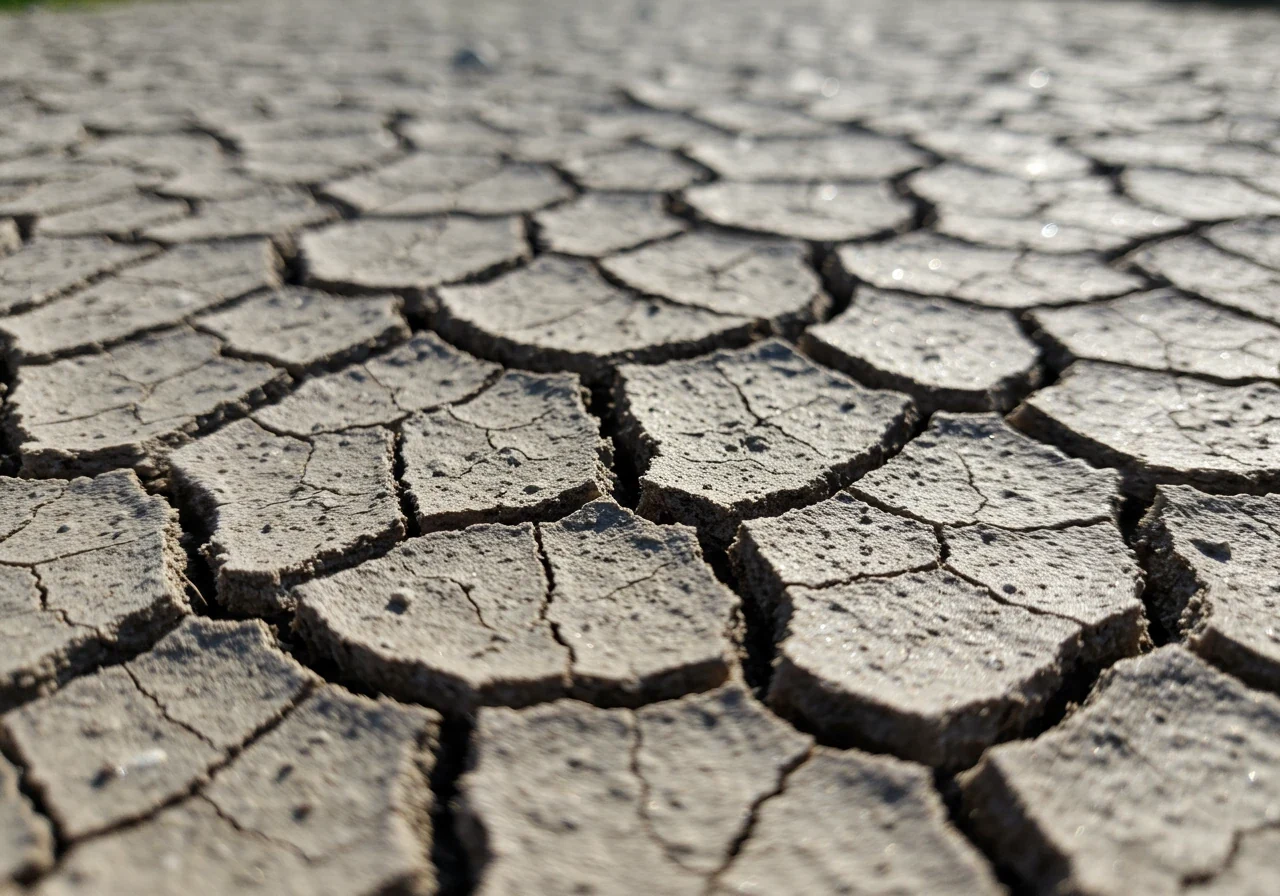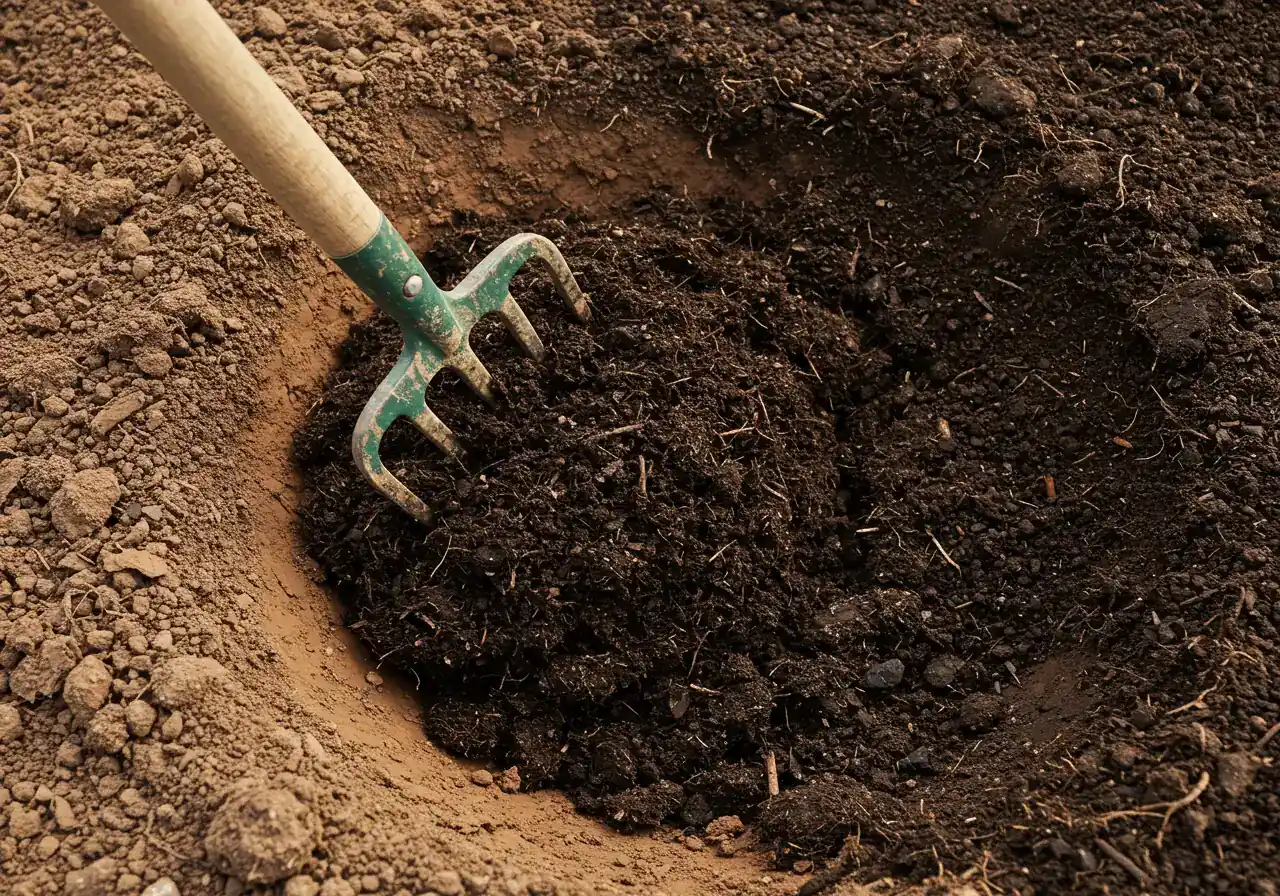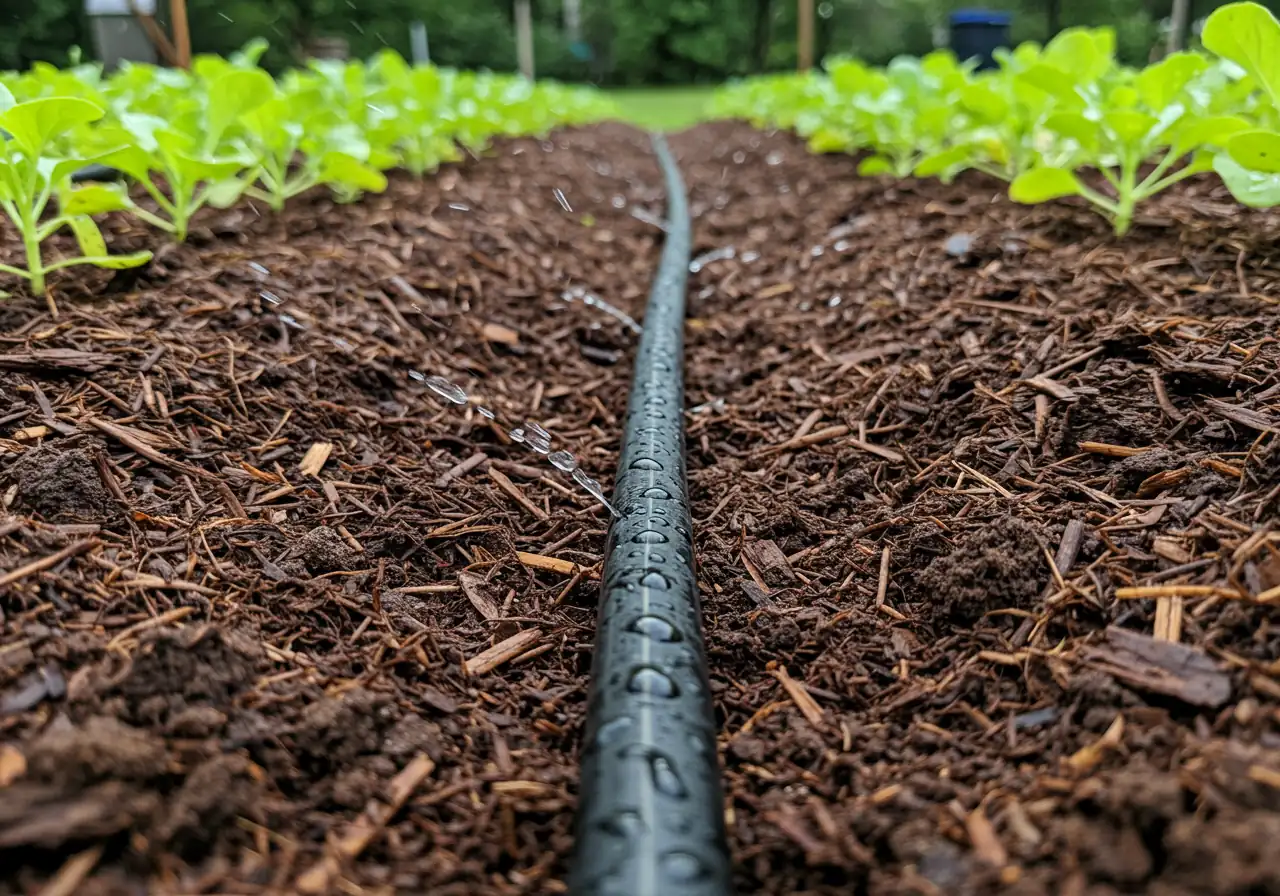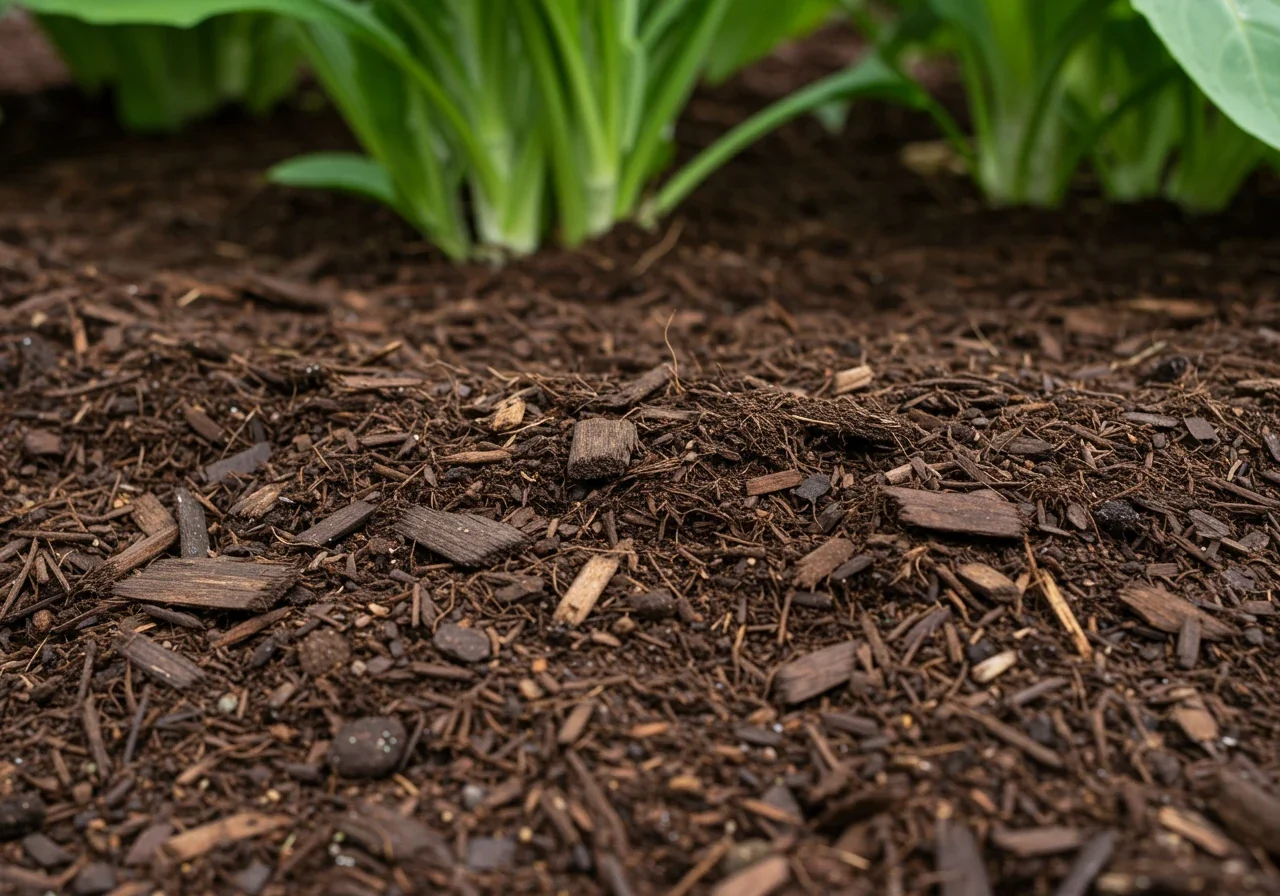Boost Metcalfe Veggie Harvest: Summer Clay Soil Care Tips
Quick Summary: Clay Soil Success
Struggling with heavy clay soil in Metcalfe? Boost your summer veggie harvest with these tips:
- Understand clay soil's properties (poor drainage, compaction).
- Amend soil generously with organic matter (compost is key!).
- Mulch effectively to conserve moisture and moderate temperature.
- Water deeply and infrequently using methods like soaker hoses.
- Choose clay-tolerant vegetables or use raised beds.
- Perform ongoing summer care: gentle feeding, avoid compaction.
Ready to transform your garden but need a hand? Get a personalized quote today!
Request Your Free QuoteIntroduction: Kiss Your Metcalfe Clay Soil Woes Goodbye (and Hello Veggies!)
Hey Metcalfe gardeners! Does your summer vegetable patch sometimes feel less like fertile ground and more like baked brick? You spend the spring dreaming of juicy tomatoes and crisp lettuce, only to find yourself battling soil that’s either a sticky mess or cracked hardpan once the real Ottawa heat arrives. You are *definitely* not alone! That heavy clay soil, common not just in Metcalfe but also familiar to our neighbours in Greely and Osgoode, can be a challenge, especially with our region's unique climate swings.
But don't despair or trade your shovel for a pottery wheel just yet! Wrestling with clay doesn't mean giving up on your garden dreams. In fact, with a little know-how and some practical steps, you can transform that stubborn soil into a thriving haven for your vegetables. This guide is here to show you how. We'll explore simple, effective soil amendment techniques and gardening strategies specifically designed to improve drainage, boost fertility, and make your clay soil work *for* you. Get ready to say goodbye to frustration and hello to happy roots and delicious harvests!
Decoding Your Backyard: Understanding Clay Soil in the Ottawa Region

Alright, let's talk dirt! Specifically, that famous (or infamous?) Ottawa region clay soil. If you're gardening in areas like Metcalfe, Greely, Osgoode, or even parts of Nepean and Barrhaven, you've likely had some *adventures* with your soil. One minute it's a soupy mess clinging to your boots like glue, the next it's cracked and hard enough to bounce a shovel off. Sound familiar? Don't worry, you're in good company! You can find us working with homeowners across the region, check out our Google My Business page for reviews!
So, what makes clay soil tick? It all comes down to tiny particles. Clay soil particles are super fine, much smaller than sand or silt. Think of them like tiny, flat plates stacking tightly together. This structure has its perks – clay is fantastic at holding onto water and nutrients, which *can* be great for plants. It's naturally more fertile than sandy soil.
But (and it's a big but!), that tight structure is also its downfall. Because the particles are so close, there's very little space for air or water to move through easily. This leads to a few classic clay challenges:
- Poor Drainage: After a heavy Ottawa rain (or spring melt!), water just sits there. Plant roots can literally drown if they stay waterlogged too long.
- Compaction: Foot traffic, heavy equipment, even just gravity over time squishes those tiny particles even closer. This makes it incredibly hard for roots to penetrate and find what they need. Regular aeration is key to combat this – you can learn more about timing with these Nepean Spring Lawn Aeration Insights or explore the benefits later in the season with these Greely Fall Lawn Aeration Secrets.
- Summer Baking: When our hot, dry summers hit, the water clay *was* holding evaporates, causing the soil to shrink, crack, and harden into something resembling concrete. This stresses plants and makes watering tricky. Applying mulch is a great way to moderate soil temperature and moisture; check out these helpful Spring Mulching Tips for Clay Soil.
- Difficult to Work: Digging in wet clay is messy and heavy. Digging in dry clay requires a pickaxe and a strong back! Timing is everything.
Quick Clay Check: Not sure if you have clay? Try the ribbon test! Grab a small handful of moist (not soaking wet) soil. Roll it into a ball, then try to squeeze it between your thumb and forefinger, pushing it upwards to form a ribbon. If you can form a ribbon longer than 2.5 cm (1 inch) before it breaks, you've likely got clay soil. The longer and stronger the ribbon, the higher the clay content. For more soil identification help, check resources from the Master Gardeners of Ottawa-Carleton.
Understanding these characteristics is the first step to making clay soil work *for* you, not against you. It's not about fighting the clay, but learning how to improve its structure and choose plants that don't mind its quirks. Even challenging soil can support beautiful landscapes with the right approach – knowing specific plant needs, like following Metcalfe Lilac Pruning Tips, helps ensure success. If tackling heavy soil improvement feels overwhelming, remember that professional help is available through Our Landscaping and Yard Care Services. Next up, we’ll dive into how to actually *improve* this tricky soil!
The Dirt on Improvement: Amending Clay Soil for Summer Success

Okay, so we know our Ottawa clay soil can be a bit of a diva – demanding, hard to work with, and prone to dramatic swings between soggy and cement-like. But fear not! You *can* coax it into being a fantastic growing medium. The secret? Amendments! Think of it like giving your soil a spa day and a healthy meal all rolled into one.
Why Bother Amending? The Perks are HUGE!
Amending heavy clay isn't just about making digging easier (though that's a definite bonus!). Adding the right stuff fundamentally changes the soil structure for the better:
- Improves Drainage: Organic matter helps create small pockets and channels, allowing excess water to drain away instead of pooling around plant roots. Goodbye, soggy bottom blues!
- Boosts Aeration: Those same pockets let air circulate, which roots need just as much as water. Happy roots = happy plants.
- Adds Nutrients: Organic materials break down over time, slowly releasing essential nutrients that feed your plants. It’s like a slow-release fertilizer, built right in.
- Makes Soil Workable: Amended clay is less sticky when wet and less prone to cracking when dry. Your shovel (and your back!) will thank you.
- Encourages Healthy Biology: Good soil is alive! Organic matter feeds beneficial microbes and earthworms, which further improve soil structure and health. This is a core part of our Garden Maintenance philosophy.
The Magic Ingredient: Organic Matter
When we talk about amending clay, we're mostly talking about adding *organic matter*. This is the decomposed goodness derived from plants and animals. Forget adding sand – mixing sand into heavy clay often creates a substance closer to concrete than fluffy loam. Stick with the organics! Here are your best options:
- Compost: The undisputed champion! Well-rotted compost (homemade or store-bought) is packed with nutrients and instantly improves structure.
- Aged Manure: Ensure it's well-rotted (at least 6 months old) to avoid burning plants. Cow, sheep, or mushroom manure are great choices.
- Leaf Mold: Decomposed leaves are fantastic soil conditioners. Rake them up in the fall, let them break down, and add them in the spring. Learn more about leaf management in our Ottawa Yard Cleanup Service details.
- Cover Crops: Planting things like clover or rye in the off-season and then tilling them in adds organic matter directly.
Using Compost
Compost is the gold standard for improving clay. It adds a wide range of nutrients, improves soil structure immediately, and feeds beneficial soil microbes. Aim for compost that looks dark, crumbly, and smells earthy. You can make your own or purchase bagged or bulk compost. Mix several inches into your beds each year.
Using Aged Manure
Well-rotted manure (cow, sheep, horse, chicken) is rich in nitrogen and organic matter. *Crucially*, it must be aged for at least 6 months to prevent burning plant roots due to high ammonia content. Mix it thoroughly into the soil like compost. Be mindful of the source to avoid persistent herbicides.
Using Leaf Mold
Decomposed leaves create a wonderful, fungus-rich amendment called leaf mold. It's particularly good at improving soil moisture retention and structure. Collect leaves in fall, moisten them, and let them break down in a pile or bin for 1-2 years. It's less nutrient-rich than compost but an excellent conditioner.
Let's Get Dirty: How to Amend Your Clay Soil
Ready to transform that tough turf? Here’s the game plan:
- Timing is Key: The *best* time to amend in the Ottawa region is typically fall or spring. Avoid working the soil when it’s soaking wet (you'll just compact it more) or bone dry and hard. Aim for slightly moist.
- Spread it Thick: Don't be shy! Spread a generous layer of your chosen organic matter – about 2 to 4 inches (5-10 cm) thick – over the surface of the garden bed or area you want to improve. If you're prepping for a brand new garden, this step is crucial before any planting happens; expert help with soil prep is part of our Garden Install services. Our team has experience working across the city, including providing City Garden Clean Up Services.
- Dig it In: Use a sturdy spade, garden fork, or tiller to mix the organic matter into the top 6 to 12 inches (15-30 cm) of your clay soil. The goal is to incorporate it thoroughly, breaking up clumps and blending the materials.
- Repeat Annually (or Biannually): Amending isn't usually a one-and-done deal, especially with heavy clay. Adding a layer of compost each spring or fall will continue to improve the soil over time. This complements regular yard maintenance like our professional Lawn Care programs that focus on overall soil health.
Local Sourcing & An Eco-Tip
Finding good quality amendments is important. Local garden centers are a good start, and sometimes you can find well-aged manure from farms in surrounding areas like Richmond or Winchester. When selecting amendments, knowing what works best for your specific needs is key; you can explore options with our guide to Material Selection. If sourcing and hauling bulky materials feels like too much, remember that handling soil amendments can be part of broader services like a Richmond Yard Cleanup Service or included in the wide range of Our Landscaping and Yard Care Services.
Eco-Friendly Tip: Start composting! Setting up a simple backyard compost bin turns kitchen scraps (no meat/dairy) and yard waste into black gold for your garden. It reduces landfill waste and gives you a free source of fantastic soil amendment. The City of Ottawa offers resources on backyard composting.
Improving clay soil takes a bit of effort, but the payoff in healthier plants and easier gardening is well worth it. Happy amending!
Let us handle the heavy lifting! We offer professional soil amendment services.
Get Professional Help With Soil PreparationWater Wisely: Quenching Your Clay Soil Garden's Thirst


Alright, let's talk hydration! Watering clay soil can feel a bit like trying to give a stubborn toddler a drink – it either takes forever to sink in or just runs right off. Especially during those unpredictable Ottawa summers, where one week feels like the tropics and the next brings Sahara-like conditions to gardens in Nepean and Vernon, getting watering right is crucial. Clay holds onto water tightly, which *can* be good, but it also means water penetrates slowly and can easily pool or run off if you're not careful.
The golden rule for watering clay soil gardens? Water deeply, but less frequently. Forget those quick daily sprinkles! They only wet the top inch or so, encouraging shallow roots that suffer badly when the surface inevitably dries out and bakes hard. Instead, aim for long, slow soaking sessions.
Why Deep Watering is King:
- Encourages Strong Roots: When water sinks deep, roots follow it down, creating a more resilient plant better equipped to handle dry spells.
- Reduces Runoff: Slow application gives the water time to actually seep into that dense clay structure instead of just washing away.
- More Efficient: You lose less water to evaporation compared to frequent, shallow watering.
Your Secret Weapon: Mulch!
Remember how we talked about amending your soil? Mulch is the superhero cape to your amended soil's utility belt. Applying a 2-3 inch layer of organic mulch (like shredded bark, wood chips, or straw – not rock, which can bake the soil even more) works wonders:
- Slows Evaporation: It acts like a lid, keeping precious moisture in the soil longer.
- Moderates Temperature: Protects roots from extreme heat and cold.
- Suppresses Weeds: Bonus! Fewer weeds competing for water.
- Improves Soil (Eventually): Organic mulches slowly break down, adding more lovely organic matter. Keep those beds tidy with proper Mulching and Edging. Keeping beds mulched and tidy also complements the benefits of a broader City Yard Cleanup Service, ensuring your whole space looks great.
Choosing Your Watering Method:
- Soaker Hoses/Drip Irrigation: Often the best choice for clay. These systems deliver water slowly and directly to the root zone, minimizing runoff and evaporation. They are especially beneficial right from the start with a new Garden Install to help establish plants.
- Hand Watering: Good for containers or hitting specific thirsty spots, but time-consuming for large areas. Use a watering wand with a breaker nozzle for a gentle flow.
- Sprinklers: Can work, but watch out! Apply water slowly (use a low-flow setting or cycle the sprinkler on and off) to allow infiltration and avoid creating puddles or runoff. Efficient watering starts with good groundwork, tying back to thorough Soil Preparation techniques.
How Much & When?
Aim for about one inch of water per week during the growing season (including rainfall). The best time to water is early morning. This allows water to soak in before the heat of the day ramps up evaporation, and lets foliage dry before nightfall, reducing disease risk.
Don't just guess! Stick your finger into the soil a few inches down. If it feels dry, it's time to water. If it's damp, hold off. A small trowel can also help you check moisture levels deeper down. Sometimes, persistent watering issues might indicate a deeper problem; getting professional advice can help, and Clean Yards values client input – feel free to Get Estimate Feedback or share your experiences. Ensuring the surrounding area is clear of debris, perhaps through a service like the Marionville Property Cleanup Service, can also make accessing beds for proper watering easier.
Eco-Friendly Tip: Install a rain barrel! Collecting rainwater provides a free, soft water source that your plants will love, reducing your reliance on tap water during dry spells. Check resources from organizations like the Rideau Valley Conservation Authority for water conservation tips.
Watering clay soil wisely takes a little patience, but by watering deeply, mulching well, and checking moisture levels, you can keep your garden happy and thriving, even when the Ottawa weather throws you a curveball.
Visualizing Improvement: Soil Amendment Benefits
*Illustrative values showing potential relative improvement in drainage and aeration after consistent soil amendment with organic matter.
Plant Power: Choosing Veggies That Don't Mind Getting Their Roots Dirty
So, you've amended your soil, mastered the art of watering clay, and now you're ready for the fun part – planting! But wait, not all veggies look at heavy Ottawa clay and think, "Ooh, cozy!" Some delicate flowers (well, vegetables) prefer fluffier digs. The good news is, plenty of hardy plants aren't afraid to get their roots dirty and can actually thrive in nutrient-rich clay, provided it drains *reasonably* well.
Think of it this way: clay soil holds onto nutrients like a champ. Plants with strong, vigorous root systems can push through the density and tap into that goodness. Others are simply more tolerant of the "wet feet" conditions that can sometimes happen after a downpour.
Here are some veggie patch heroes known for their clay tolerance:
- Beans (Bush & Pole): These guys are tough and their roots work wonders for soil structure.
- Broccoli, Cabbage, Kale & Brussels Sprouts: Members of the brassica family generally have robust root systems and appreciate the moisture-retentive nature of clay.
- Squash (Summer & Winter): Zucchini, pumpkins, and butternut squash often perform well, sending out strong roots.
- Potatoes: They can actually help break up compacted soil as the tubers expand!
- Lettuce & Swiss Chard: These leafy greens are fairly adaptable, especially if the soil surface is well-amended.
On the flip side, some veggies find clay a bit *too* challenging:
- Carrots & Parsnips: These long root veggies often get stunted, forked, or twisted trying to penetrate dense clay.
- Radishes: Similar to carrots, they prefer loose soil for quick, straight growth.
- Onions & Garlic: While they *can* grow, they prefer looser soil for bulb development and are more prone to rot if drainage is poor.
The Raised Bed Advantage
Feeling frustrated by those trickier crops? Don't give up! Raised garden beds are a fantastic solution, especially popular in areas like Barrhaven and Manotick. They allow you to create the perfect soil mix *above* the challenging clay, ensuring excellent drainage and root-friendly texture. Preparing the ground before installing raised beds is key; clearing debris or old vegetation, a task similar to what's offered by a Marionville Property Cleanup Service, ensures a clean start. You can learn more about our approach and experience on our About Us page or see examples in our Transformations gallery.
Quick Comparison: Veggie Tolerance
| Vegetable Type | Clay Tolerance | Notes |
|---|---|---|
| Beans (Bush, Pole) | High | Roots help improve soil structure. |
| Brassicas (Broccoli, Cabbage, Kale) | High | Robust roots, like moisture retention. |
| Squash (Summer, Winter) | High | Strong root systems. Need space. |
| Potatoes | High | Can help break up compacted soil. |
| Lettuce, Swiss Chard | Moderate-High | Adaptable, especially with surface amendments. |
| Tomatoes, Peppers | Moderate | Need good drainage and amendments. |
| Onions, Garlic | Low-Moderate | Prefer looser soil; risk of rot if drainage poor. |
| Carrots, Parsnips | Low | Often stunted or forked in heavy clay. |
| Radishes | Low | Need loose soil for quick, straight growth. |
Choosing the right plants makes gardening in clay soil much more rewarding. And if you need a hand getting those beds ready or tackling existing garden woes, our Ottawa Garden Clean Up Service is here to help. For larger property needs beyond just the garden beds, consider a broader City Property Cleanup Service. We appreciate you taking the time to learn with us; visit our Thank You page if you've used our services or found this helpful! Happy planting!
Summer TLC: Ongoing Care for Your Clay-Based Veggie Patch
Alright, garden warriors, you've amended, you've planted, you've mastered the slow soak watering technique – high five! But don't hang up your trowel just yet. Keeping that clay soil veggie patch thriving through the heat and humidity of an Ottawa summer requires a little ongoing tender loving care. Think of it as maintaining the good vibes you started in the spring! Consistent care is key, just like our reliable City Garden Maintenance Service.
Feeding Your Hungry Plants (Gently)
Clay soil holds onto nutrients pretty well, but hard-working veggies like tomatoes or squash can still get hungry. Instead of harsh chemical fertilizers, stick with gentler, organic options. A mid-season boost from compost tea (just soak some compost in water and use the liquid) or side-dressing (sprinkling a little compost around the base of plants) works wonders. These slow-release methods feed the soil *and* the plants without shocking the system.
Don't Stomp Your Soil Flat!
Remember how clay compacts easily? Summer foot traffic is a major culprit. Try your best to stay *out* of the garden beds, especially when the soil is wet – seriously, don't practice your tap-dancing routine after a downpour! Use designated pathways or stepping stones. That lovely layer of mulch you added? It doesn't just save water; it also cushions the soil surface, preventing that hard, cracked crust from forming and reducing compaction from raindrops.
Summer Troubleshooting: Quick Fixes
- Yellowing Leaves? Could be too much water (check drainage!) or not enough nitrogen. Let the soil dry slightly between waterings. If it persists, try a dose of compost tea.
- Soil Cracking Like Crazy? Usually means the surface is drying too fast. Check your mulch layer – is it thick enough (2-3 inches)? Water slowly and deeply when you do water.
- Plants Look Sad/Stunted? Could be compaction (see above!), pests, or disease. Investigate closely!
Battling the Bad Bugs (Eco-Style)
Pests happen! But before reaching for harsh chemicals, try eco-friendly methods. Attract beneficial insects like ladybugs (they love dill and parsley flowers!) to munch on aphids. Use row covers to protect vulnerable seedlings. Hand-pick larger pests like tomato hornworms (ew, but effective!). For persistent issues, insecticidal soap or neem oil are less harmful options. Healthy soil often means healthier, more pest-resistant plants! Keeping the surrounding area tidy also helps; fewer weeds and debris mean fewer hiding spots for pests. Managing the whole property with services like a Metcalfe Property Cleanup Service or a more general Ottawa Property Cleanup Service can reduce pest pressures on your garden beds. Sometimes, sharing tips with fellow gardeners in communities like Russell or Embrun can uncover local pest solutions.
Seasonal Clay Care Timeline (Simplified)
Amend beds heavily with compost. Check drainage. Plan layout. Warm soil before planting tender crops. Consider a spring Garden Clean Up.
Plant warm-season crops. Apply mulch (2-3 inches). Water deeply and monitor moisture. Weed regularly. Side-dress heavy feeders mid-season. Address pest issues promptly. Keep the whole yard tidy with a Metcalfe Yard Cleanup Service.
Continue harvesting. Remove spent plants. Plant cover crops or add another layer of compost/leaves to beds for winter. Consider fall aeration for lawn areas. Maybe upgrade tired lawns with Sod Installation.
Consistent summer care ensures your clay soil garden continues to reward you with delicious, homegrown goodies right through till fall!
Metcalfe Harvest Hacks: Quick Tips for Clay Soil Success
Okay, Metcalfe gardeners, feeling a bit overwhelmed by all that clay soil info? Totally understandable! Sometimes you just need the cheat sheet, right? Especially when neighbours in Greely or Osgoode seem to have their gardens figured out (spoiler: they probably faced the same struggles!).
Think of this section as your quick-reference guide, the essential "Harvest Hacks" to pin on your garden shed door. Here are the absolute must-dos for turning that tricky Ottawa clay into a veggie-producing powerhouse:
Your Quick Clay Cheat Sheet:
- Amend Like You Mean It: This is non-negotiable! Regularly mix *loads* of organic matter (compost is king!) into the top 6-12 inches of your soil. Don't skimp! This improves drainage and makes digging less like wrestling a hippo. Need a hand getting started or with the heavy lifting? A thorough service like the Marionville Garden Clean Up Service can help whip beds into shape.
- Mulch is Your BFF: Apply a 2-3 inch layer of organic mulch (wood chips, shredded bark, straw) over your amended soil. It saves water, keeps roots cool, stops compaction from rain, and suppresses weeds. Keep those edges neat too! Quality Mulching and Edging makes a huge difference visually and functionally.
- Water Smarter, Not Harder: Ditch the daily sprinkle! Water deeply and less frequently to encourage strong roots. Let the water soak in slowly – think soaker hoses or drip irrigation. Check the soil moisture a few inches down before watering again.
- Pick Proper Plants (or Go Up!): Choose veggies known to tolerate heavier soil (beans, squash, brassicas). For fussy root crops like carrots, consider raised beds filled with a lighter soil mix. Getting the whole yard ready for the season, including prepping garden areas, can be part of a larger effort, like our Marionville Yard Cleanup Service prepares properties.
- Keep Off the Grass (and Garden!): Well, keep off the *wet* garden soil, anyway. Clay compacts incredibly easily when wet. Use paths or stepping stones and avoid walking directly in your amended beds. A thriving veggie patch might even make you consider upgrading nearby lawn areas that struggle with the same clay – professional Sod Installation can provide that instant green carpet contrast.
Stick to these core principles, and you'll be well on your way to delicious harvests from your Metcalfe garden. Remember, improving clay soil is a marathon, not a sprint, but these hacks give you a running start! Still feeling stuck or need tailored advice for your specific patch of Ottawa clay? Don't hesitate to reach out – Contact Us for personalized help! Our Terms and Conditions and Privacy Policy ensure a professional and secure interaction.
Your Ottawa Clay Soil Questions Answered (FAQ)
Got questions about that stubborn Ottawa clay? You're not alone! Wrestling with heavy soil is practically a rite of passage for gardeners from Barrhaven to Greely. Here are some common queries we hear, answered simply:
Great question! The easiest way is the "ribbon test." Grab a handful of *moist* (not soaking wet) soil and try squeezing it between your thumb and forefinger, pushing upwards. If you can form a ribbon longer than about an inch (2.5 cm) before it breaks, you've likely got clay. The longer the ribbon, the heavier the clay – a common challenge for landscaping across the region, including areas needing a Metcalfe Garden Clean Up Service!
Oh boy, that's a popular myth we hear often! Unfortunately, adding sand to heavy Ottawa clay often creates something more like concrete – *not* the fluffy soil you want for gardening. Your best bet is *always* adding plenty of organic matter like compost. It helps separate those tiny clay particles, improving both drainage and aeration without turning your garden into a brick.
Compost, compost, compost! Adding generous amounts of finished compost or other well-rotted organic matter is the single most effective thing you can do. It tackles compaction, improves drainage, adds nutrients, and makes the soil easier to work. If hauling bags feels daunting, our City Garden Clean Up Service team can help incorporate amendments during a visit.
Focus on your main gardening areas first – vegetable patches or key flower beds. You don't need to fix the whole property at once! Start small, amend thoroughly where you plant most often. For larger scale issues, like clearing neglected areas before amending, professional help such as a comprehensive Property Clean Up or a focused Marionville Yard Cleanup Service if you're nearby, can make a big difference.
Raised beds are a fantastic solution, especially for root vegetables that really dislike dense soil! They offer immediate control over soil quality and guarantee good drainage right from the start. The downside is the initial cost and effort to build and fill them. Amending existing soil takes longer but improves your native soil over time. It often comes down to budget, effort, and what you want to grow! We can help with both approaches through our Garden Install services.
We get it – every yard has its unique quirks! For personalized gardening tips, feel free to contact us directly. We often help homeowners tackle specific clay soil challenges. And rest assured, when you share information with us to get advice or a quote, your details are kept confidential as outlined in our Privacy Policy. Sometimes a quick chat can solve a big headache!
Reap What You Sow: Enjoy Your Delicious Metcalfe Harvest!
Well folks, you've made it! You've waded through the world of Ottawa clay, from understanding its quirky personality to learning how to coax it into becoming a happy home for your vegetables. See? Gardening in Metcalfe, even with that heavy soil, isn't just possible – it can be incredibly rewarding! Remember those sticky, cracked ground blues? They don't have to be your reality.
The key takeaways? It really boils down to a few simple, consistent actions:
- Amend, Amend, Amend: Seriously, load up on that compost and organic matter. Your soil will thank you!
- Mulch Like a Pro: It's the superhero cape your garden needs for moisture retention and temperature control.
- Water Wisely: Deep soaks, less often – teach those roots to reach!
- Plant Smart: Choose veggies that don't mind getting their feet dirty, or give tricky crops a boost with raised beds.
Stick with these strategies, and you’ll be well on your way from battling the backyard brickyard to boasting about your bounty. Imagine those fresh salads, juicy tomatoes, and crisp beans – all homegrown!
Feeling inspired but maybe a bit overwhelmed by the digging and hauling? Don't let the hard work stop you from enjoying a fantastic harvest. Whether you're in Metcalfe, over in Kenmore, or down near Vernon, our Clean Yards team is ready to lend a hand. From soil amending and garden preparation to full yard cleanups like our Metcalfe property cleanup service, we can help you get your veggie patch primed for success. Give these tips a try, and get ready to enjoy the delicious fruits (and veggies!) of your labour!
Ready for a bountiful harvest without the backache? Contact Clean Yards!
Explore Our Gardening Services
